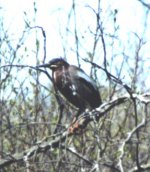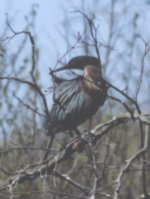Good Afternoon,
Can you wise folks tell me what the heck this is? I was stalking woodducks (with my canon) on a pond out back in early May and came across this fellow perched on a branch over the pond. He/she was about the size of a crow, was quite interested in grooming, had these long sort of hairy looking feathers, did not make any noise that I heard, and did not seem bothered by my presence about 25 feet away. The closest thing I can find is a least bittern, but this guy/girl does not look exactly like the ones in my ID books or anything that I've seen online.
Not sure how well the color shows up in the photos, but the head and back were slate gray, neck and breast were brown, feet were orange.
Thanks!
Angie
Can you wise folks tell me what the heck this is? I was stalking woodducks (with my canon) on a pond out back in early May and came across this fellow perched on a branch over the pond. He/she was about the size of a crow, was quite interested in grooming, had these long sort of hairy looking feathers, did not make any noise that I heard, and did not seem bothered by my presence about 25 feet away. The closest thing I can find is a least bittern, but this guy/girl does not look exactly like the ones in my ID books or anything that I've seen online.
Not sure how well the color shows up in the photos, but the head and back were slate gray, neck and breast were brown, feet were orange.
Thanks!
Angie





